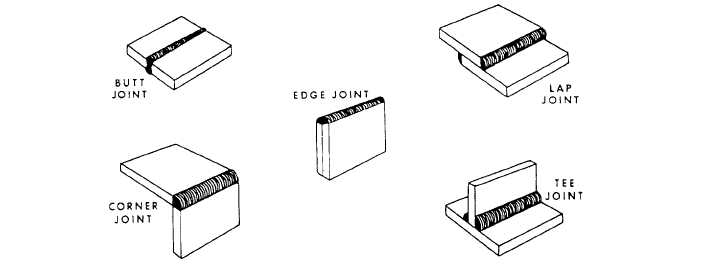Figure 15-35.—Types of welded joints.
commonly used joints. Notice that the corner joint and
butt joint are classified as groove welds, while the tee
and lap joints are classified as fillet welds.
Welding is always done in the flat position
whenever possible. The puddle is much easier to control,
and the welder can work longer periods without tiring.
Quite often it is necessary to weld in the overhead,
vertical, or horizontal position in equipment repair.
The flat position is used when the material is to be
laid flat or almost flat and welded on the topside. The
welding torch is pointed downward toward the work.
This weld may be made by either the forehand or
backhand technique.
The overhead position is used when the material is
to be welded on the underside, with the torch pointed
upward toward the work. In welding overhead, you can
keep the puddle from sagging if you do not permit it to
get too large or assume the form of a large drop. The rod
is used to control the molten puddle. You should not
permit the volume of flame to exceed that required to
obtain a good fusion of the base metal with the filler rod.
Less heat is required in an overhead weld because the
heat naturally rises.
The horizontal position is used when the line of the
weld runs horizontal across a piece of work, and the
torch is directed at the material in a horizontal or near
horizontal position. The weld is made from right to left
across the plate (for the right-hand welder). The flame
is inclined upward at an angle of 45° to 65°, and the weld
is made with a normal forehand technique. Adding the
rod to the top of the puddle will prevent the molten metal
from sagging to the lower edge of the bead. If the puddle
is to have the greatest possible cohesion, it should not
be allowed to get too hot.
In a vertical weld, the pressure exerted by the torch
flame must be relied upon to a great extent to support
the puddle. It is important to keep the puddle from
becoming too hot, and to prevent the hot metal from
running out of the puddle onto the finished weld. It may
be necessary to remove the flame from the puddle for
an instant to prevent overheating, and then return it to
the puddle. Vertical welds are begun at the bottom, and
the puddle is carried upward with a forehand motion.
The tip should be inclined from 45° to 60°, the exact
angle depending upon the desired balance between
correct penetration and control of the puddle. The rod is
added from the top and in front of the flame with a
normal forehand technique.
Welded Joints
The properties of a welded joint depend partly on
the correct preparation of the edges being welded. All
mill scale, rust oxides, and other impurities must be
removed from the joint edges or surfaces to prevent their
inclusion in the weld metal. You should prepare the
edges to permit fusion without excessive melting, and
you should take care to keep to a minimum the heat loss
due to radiation into the base metal from the weld. A
properly prepared joint will give a minimum of
expansion on heating and a minimum of contraction on
cooling.
15-26

